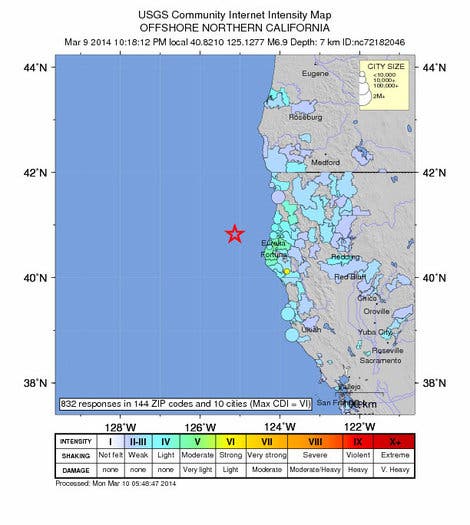A magnitude 6.9 earthquake off the coast of Northern California struck Sunday night, on the 9th of March. It was the largest on the West Coast since the 7.2 Baja California quake in 2010 and it was followed by a series of at least 13 aftershocks, the largest of which had magnitude of 4.6, according to the USGS.
The earthquake was shallow in depth (at approximately 6 km deep) and occurred 70 kilometers west of Eureka in Humboldt County in the Pacific Ocean; however, the aftershocks were closer to the mainland, the biggest one being at approximately 20 km offshore.
Local authorities represented by Eureka Police Department Sgt. Brian Stephens said there had been no reports of significant damage or injuries.
“My car was rocking back and forth,” Stephens, who was on out on a call when the earthquake hit, told The Times. “I thought someone was shoving my car back and forth, looked around and nobody was there. Then I realized what was happening.”
The activity on the West Coast appears to intensify, and most seismologists seem to agree that California is way overdue for a major earthquake. In 2008, a report concluded that California has 99% chances of big earthquake in 30 years – which means that today, there’s a 99% chance of a major earthquake in 24 years – and the US has done little to prepare itself for this apparently inherent catastrophe on the San Andreas fault.
We’re talking a major earthquake, something over 7.5 magnitude. Of course, these things are literally impossible predict, but you could speak in term of probabilities (hence the report mentioned above). A team of researchers lead by Thomas Jordan of the University of Southern California has simulated an earthquake in 3-D, using the world’s fastest computer, to see how the ground would shake throughout Southern California and into Mexico in the event of a magnitude 8.0 earthquake centered northwest of Los Angeles. The results would be absolutely and horribly devastating – so why then are the US not better preparing themselves?
I don’t know. It may be a case of just closing your eyes and hoping the danger goes away (which it won’t happen), or maybe something more cynical, like keeping the price and the value of the area as high as possible, without panicking the population and lowering property value. Either way, they’d best try a little harder.











